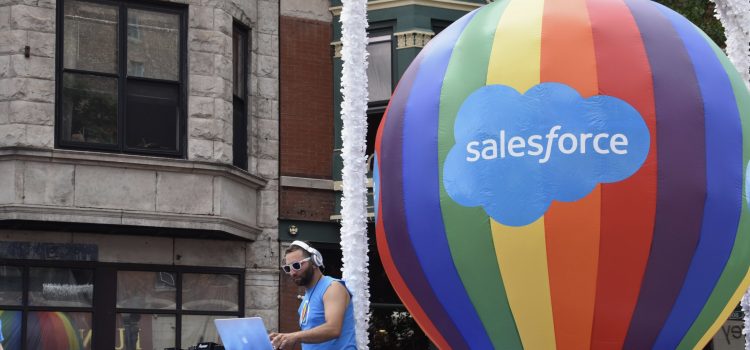

This article is an excerpt from the Shortform book guide to "Trailblazer" by Marc Benioff and Monica Langley. Shortform has the world's best summaries and analyses of books you should be reading.
Like this article? Sign up for a free trial here.
Why is diversity and inclusion important in any business? How does Salesforce create an equal space for all of its employees?
Marc Benioff explains that he’s always striven for inclusivity at Salesforce. However, he didn’t explicitly focus on this principle until two key incidents brought Salesforce’s underperformance in this area to his attention.
Let’s look at the two incidents that persuaded Benioff to improve Salesforce’s diversity and inclusion plan.
How Salesforce Practices Inclusivity
The first issue that called for more diversity and inclusion at Salesforce was an audit that showed that women were being underpaid compared to men across the board. (Shortform note: Research suggests that this issue is par for the course in the tech industry, where women make up a significantly smaller portion of the workforce, tend to be paid less than men doing the same jobs they are, and are less likely to be promoted.)
Second, when Benioff tweeted that the technology industry could help end racial strife amid the protests that ensued after the police killings of Alton Sterling and Philando Castile in 2016, there was a controversy over the lack of racial diversity among Salesforce employees (only 2% were Black). Benioff says he learned from these experiences and began pouring resources into making Salesforce a more equitable company.
(Shortform note: Experts note that the technology industry has served a purpose in the fight for racial justice—for example, the viral spread of videos of police violence, including the killings of Sterling and Castile, helped to inform white Americans about the realities of anti-Black police brutality and sparked nationwide protests and calls for reform. But the public is critical when tech giants and their billionaire leaders, including Benioff, make performative gestures of solidarity: These can be interpreted as self-serving and insincere, especially when those gestures aren’t matched by meaningful action—like donating to pro-Black causes or simply employing more Black people.)
Benioff says that once he became aware of Salesforce’s shortcomings with regard to gender inclusivity, he took decisive action to transform the company into a more gender-egalitarian workplace. This began with the Women’s Surge program, which aimed to increase the number of women working at Salesforce and continued with efforts to standardize pay and promotion tracks for gender parity. In addition to these structural changes, Salesforce invests in education and awareness, offering workshops and training sessions to help managers and employees unlearn unconscious bias—a type of automatic, unintentional prejudice that can lead to inequitable treatment—and foster a more inclusive workplace culture.
(Shortform note: Experts say the Women’s Surge program made a concrete, if small, difference in gender equity at Salesforce, although some experts, like social psychologist Jennifer Eberhardt (author of Biased) are somewhat skeptical of the effectiveness of workplace bias training. Improving gender equity within the company remains on the company’s radar: In 2022, Salesforce announced that it would aim for 40% of its workforce to comprise women and nonbinary people by 2026. The company also said it had expanded its benefits to accommodate the needs of people of all genders, including access to gender-affirmative and reproductive healthcare.)
Benioff explains that Salesforce also pursues racial, religious, and LGBT inclusivity in several ways. For example, after speaking to a Black employee who told him she felt Salesforce didn’t take inclusivity seriously enough, Benioff appointed a Chief Equality Officer to address that. Salesforce also donates resources, including employee time, to causes that train minority students in computer science competencies, and it makes an effort to hire a greater number of underrepresented minority employees through its recruitment programs. Finally, Salesforce encourages minority employees to connect with each other by creating safe, identity-based discussion groups.
(Shortform note: The Chief Equality Officer stated that his priorities would include improving employee diversity and enhancing inclusivity by ensuring that all employees feel respected and valued in the workplace. Salesforce’s identity-based discussion groups, which include groups for those with disabilities, veterans, and environmentalists, function like employee resource groups, which have been found to be effective in fostering more inclusive work environments. However, it’s unclear how much progress Salesforce has made with respect to diversity and inclusion: In 2021, two managers, both Black women, left the company citing a racist work environment, and some shareholders stated in 2022 that the company still underemploys people of color, a trend which persisted through 2023.)

———End of Preview———
Like what you just read? Read the rest of the world's best book summary and analysis of Marc Benioff and Monica Langley's "Trailblazer" at Shortform.
Here's what you'll find in our full Trailblazer summary:
- What “principled business” means and why it matters to you
- The priority that Salesforce—a Fortune 500 company—puts before profit
- How capitalism can look different in the future






